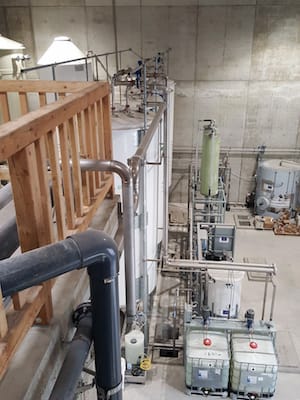 Emeryville, Calif. — New Logic Research announced the successful commissioning of a VSEP® vibrating membrane system to make clean water from digested cow manure. The VSEP system, located in the Italian Alps region of Wipptal, takes the effluent from an anaerobic digester and transforms it into clean water which can either be reused or safely discharged to the environment. The project was implemented with the expert assistance of O.B. Impianti, New Logic’s distribution partner in Northern Italy.
Emeryville, Calif. — New Logic Research announced the successful commissioning of a VSEP® vibrating membrane system to make clean water from digested cow manure. The VSEP system, located in the Italian Alps region of Wipptal, takes the effluent from an anaerobic digester and transforms it into clean water which can either be reused or safely discharged to the environment. The project was implemented with the expert assistance of O.B. Impianti, New Logic’s distribution partner in Northern Italy.
Although cows have a simple diet, the digestive system of ruminant animals makes for complicated wastewater treatment scenarios. VSEP’s patented vibratory shear mechanism coupled with an innovative filter pack design means it can uniquely create crystal clear permeate from water heavily laden with biological material like cow manure.
“Digesters are great at making green power and reducing contaminant levels in the waste, but in most cases, further treatment of the liquid effluent is still necessary. Many have tried to treat digester effluent with standard spiral-wound reverse osmosis membrane systems only to find that it’s incredibly difficult, if not impossible,” said New Logic CEO Greg Johnson. “That’s why VSEP® is a perfect fit for digester effluent treatment: you get the reverse osmosis separation you desire, but deployed in a robust system designed to tackle the world’s toughest applications.”
The Wipptal project is a cooperative one, taking cow manure from more than three dozen local farmers. The liquid manure is transported to the treatment facility where more than 60% of it is transformed into clean water, while the remainder is turned into concentrated organic fertilizer. The only pretreatment between the digester and the VSEP is a 100 micron screening device to remove large particles from the feed material.
O.B. Impianti and New Logic are already building on the success of the Wipptal installation—they are currently working on two additional installations on the continent, where EU funding is frequently available for such projects.




Join the conversation: